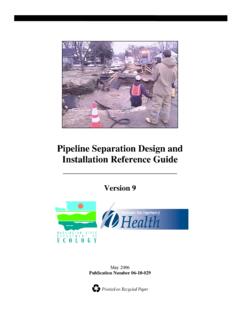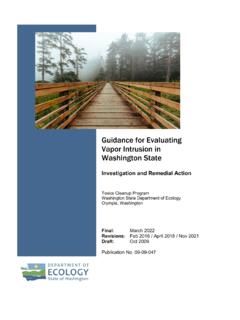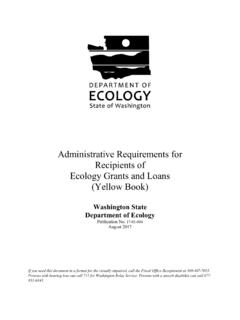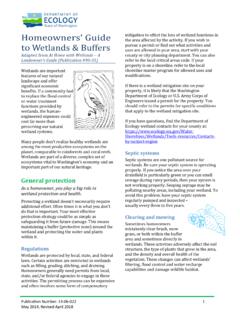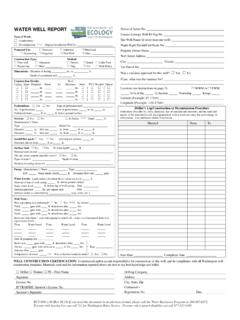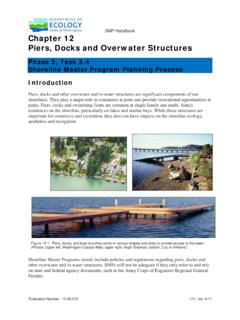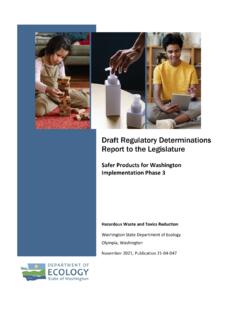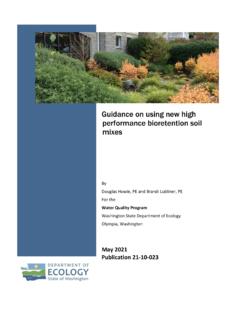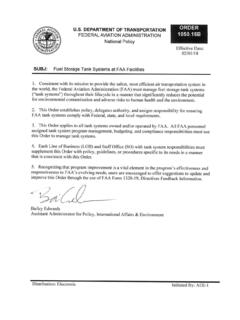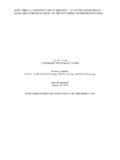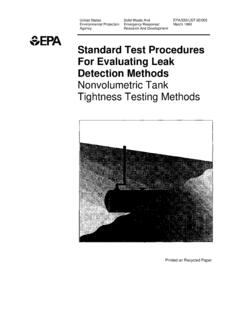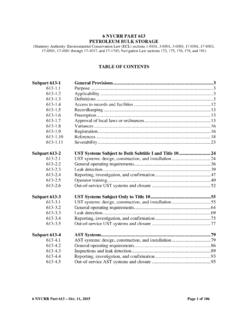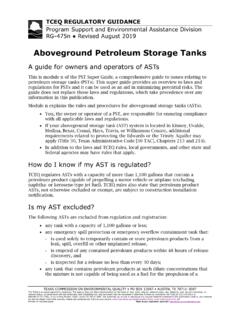Transcription of Guidance for Remediation of Petroleum Contaminated Sites
1 Guidance for Remediation of Petroleum Contaminated Sites Toxics Cleanup Program Publication No. 10-09-057 REVISED June 2016 Publication and Contact Information This report is available on the Department of Ecology s website at For more information contact: Toxics Cleanup Program Box 47600 Olympia, WA 98504-7600 360-407-7170 Washington State Department of Ecology - o Headquarters, Olympia, 360-407-6000 o Northwest Regional Office, Bellevue, 425-649-7000 (Island, King, Kitsap, San Juan, Skagit, Snohomish, Whatcom Counties) o Southwest Regional Office, Olympia, 360-407-6300 (Clallam, Clark, Cowlitz, Grays Harbor, Jefferson, Lewis, Mason, Pacific, Pierce, Skamania, Thurston, Wahkiakum Counties) o Central Regional Office, Yakima, 509-575-2490 (Benton, Chelan, Douglas, Klickitat, Yakima, Kittitas, Okanogan Counties) o Eastern Regional Office, Spokane, 509-329-3400 (Adams, Asotin, Columbia, Ferry, Franklin, Garfield, Grant, Lincoln, Pend Oreille, Spokane, Walla Walla, Whitman) Accommodation Requests: To request ADA accommodation including materials in a format for the visually impaired, please call Ecology s Toxics Cleanup Program at 360-407-7170.
2 Persons with impaired hearing may call Washington Relay Service at 711. Persons with speech disability may call TTY at 877-833-6341. Guidance for Remediation of Petroleum Contaminated Sites Toxics Cleanup Program Toxics Cleanup Program Washington State Department of Ecology Olympia, Washington Publication No. 10-09-057 REVISED June 2016 This page left intentionally blank. Guidance for Remediation of Petroleum Contaminated Sites Washington State Department of Ecology - Pub. No. 10-09-057 Page vii Table of Contents List of Figures .. xiii List of Tables .. xiv Acronyms & Abbreviations .. xvii Preface .. xix Disclaimers .. xxi Introduction .. 1 Background .. 1 Applicability of this Guidance .. 1 Organization of this Guidance .. 2 Gaining Approval from Ecology for Your Cleanup .. 3 Voluntary Cleanup Program ..3 Consent Decree ..3 Agreed Order.
3 4 Enforcement Order ..5 Private Right of Action .. 5 Financial Assistance .. 5 Other Publications and Resources .. 6 Regulations .. 11 underground storage Tank Regulations, Chapter 173-360 WAC .. 11 Site Cleanup Regulations, Chapter 173-340 WAC .. 11 Sediment Management Standards, Chapter 173-204 WAC .. 12 Regulatory Requirements for underground storage tanks on Tribal Lands .. 13 Land within Indian Reservations .. 13 Off-Reservation Tribal Trust Land .. 13 EPA Contact Information .. 14 Guidance for Remediation of Petroleum Contaminated Sites Washington State Department of Ecology - Pub. No. 10-09-057 Page viii Requirements for Releases from Regulated underground storage Tank Systems .. 15 UST Systems Release Reporting Requirements .. 15 Home Heating Oil tanks .. 17 Regulated underground storage tanks .. 18 Confirming and Reporting a Release (WACs 173-340-450(2) & 173-360-360).
4 18 Conducting Emergency Actions (WAC 173-340-450(2)) .. 18 Conducting Interim Actions (WAC 173-340-450(3)) .. 19 Status Report (WAC 173-340-450(5)(a)) .. 19 Site Characterization Report (WAC 173-340-450(5)(b)) .. 20 Remedial Investigation/Feasibility Study (RI/FS) (WAC 173-340-450(6)) .. 21 Cleanup Action Requirements .. 21 Site Characterization: General 23 Location of underground Utilities .. 23 Health and Safety .. 24 Professional License Requirements .. 25 Drilling Method and Boring/Well Installation Requirements .. 26 Expedited Site Assessment .. 27 Data Management .. 28 Management of Investigative Wastes .. 28 Horizontal and Vertical Datum and Survey Precision and Accuracy .. 31 Field Screening .. 33 Quality Assurance for Field Screening Methods .. 33 Soil Gas Surveys .. 34 Field Screening Methods .. 35 Visual Screening .. 35 Sheen Test .. 35 Non Aqueous Phase Liquid (NAPL) Jar Tests.
5 36 Headspace Vapor 36 Colormetric Test Kits / Immunoassays .. 38 Fiber Optic Chemical Sensors (measures TPH) .. 39 Field or Mobile Laboratories .. 40 Guidance for Remediation of Petroleum Contaminated Sites Washington State Department of Ecology - Pub. No. 10-09-057 Page ix Conducting an Effective Site Characterization .. 41 Immediate Risk 42 Regulatory Requirements for Remedial Investigations .. 42 Use of a Conceptual Site 43 Conceptual Site Model Review Existing Information .. 44 Conceptual Site Model Visit the Site .. 48 Conceptual Site Model Conceptualize (visualize) the Site .. 48 Conceptual Site Model Determine Potential Exposure Pathways and Preliminary Cleanup Levels .. 48 Conceptual Site Model--Identify Potential Remedial Options .. 49 Sampling and Analysis Plan .. 50 Data Quality Objectives .. 52 General Facility Information and Map .. 53 Surface Water and Sediment Characterization.
6 54 Soil and Bedrock Characterization .. 55 Soil Characterization Number of Soil 60 Soil Characterization Sampling Soil Stockpiles .. 60 Soil Characterization Sampling Excavation Margins .. 62 Soil Characterization Focused vs. Grid Soil Sampling .. 65 Geology and Groundwater Characterization .. 66 Is installation of groundwater monitoring wells necessary? .. 66 Groundwater Characterization Number of Monitoring Wells .. 68 Groundwater Characterization Determining the Direction of Groundwater Flow .. 69 Groundwater Characterization Determining Hydraulic Conductivity of Water Bearing Units .. 71 Groundwater Characterization Groundwater Contaminant 72 Groundwater Characterization What to do When Contamination Extends Beyond the Facility Property .. 74 Characterizing Petroleum Source Areas .. 74 Vapor Characterization .. 76 Land Use .. 77 Natural Resources and Ecological Receptors.
7 78 Why Terrestrial Ecological Evaluations Are Needed .. 79 Terrestrial Ecological Evaluation Requirements .. 79 Guidance for Remediation of Petroleum Contaminated Sites Washington State Department of Ecology - Pub. No. 10-09-057 Page x Terrestrial Ecological Evaluations at Commercial and Industrial Sites .. 82 Criteria for Exclusion from Terrestrial Ecological Evaluations .. 83 Simplified Terrestrial Ecological Evaluations Criteria .. 85 Conducting a Simplified Terrestrial Ecological Assessment .. 86 Site-Specific Terrestrial Ecological Evaluations .. 88 Required Documentation for Terrestrial Ecological Evaluations .. 89 Regulatory Classifications of Affected Media .. 89 Check for Data 91 Presentation of Site Characterization Results .. 92 Test Recommendations and Analytical Methods .. 93 How to Decide What to Test For .. 93 Special Testing Considerations for Natural Attenuation and Sediments.
8 96 Total Petroleum Hydrocarbons (TPH) .. 97 BTEX and Trimethyl Benzene .. 100 MTBE .. 100 Lead, EDB, and EDC .. 100 Carcinogenic Polycyclic Aromatic Hydrocarbons (cPAHs) .. 101 Naphthalenes .. 101 Polychlorinated Biphenyls (PCBs) .. 101 Other Additives/Components .. 103 Establishing Petroleum Cleanup Levels .. 109 General Overview .. 109 What if the cleanup regulations change during cleanup? .. 110 Are site-specific cleanup levels worth the additional analytical expense? .. 110 Method A Soil Cleanup Levels .. 115 Method B Soil Cleanup Levels .. 117 Method C Soil Cleanup Levels .. 129 Groundwater Classification .. 130 Method A Groundwater Cleanup Levels .. 132 Method B Groundwater Cleanup Levels .. 133 Surface Water Cleanup Levels .. 137 Air Cleanup Levels .. 142 Guidance for Remediation of Petroleum Contaminated Sites Washington State Department of Ecology - Pub.
9 No. 10-09-057 Page xi Establishing Points of Compliance .. 143 Soil Point of Compliance .. 143 Groundwater Point of Compliance .. 144 Surface Water Point of Compliance .. 147 Air Point of Compliance .. 150 Sediment Point of Compliance .. 150 Determining Compliance with Cleanup 151 Determining Compliance with Soil Cleanup Standards .. 151 Direct Comparison: .. 152 Statistical Evaluation: .. 153 Special Considerations for Method B Soil Cleanup Standards .. 154 Determining Compliance with Groundwater Standards .. 156 Determining Groundwater Compliance using Direct Comparison .. 157 Determining Compliance Using Statistics .. 162 Determining Compliance with Surface Water Cleanup Standards .. 162 Determining Compliance with Air Cleanup Standards .. 163 Determining Compliance with Sediment Cleanup Standards (WAC 173-204) .. 163 Remedial Action Alternatives and Permit 165 Requirements for the Selection of Cleanup Remedies.
10 165 Permits and Other Regulatory Requirements .. 166 State Environmental Policy Act (SEPA) .. 166 Air 167 Solid Waste .. 167 Dangerous (Hazardous) Waste .. 168 Toxic Substances Control Act .. 168 Water Quality Permits .. 168 Shoreline Management and Wetlands .. 171 Water Resources .. 171 underground Injection Wells .. 171 Zoning and Local Permits .. 172 Handling of Contaminated Soils and Water .. 172 Guidance for Remediation of Petroleum Contaminated Sites Washington State Department of Ecology - Pub. No. 10-09-057 Page xii Contaminated Material Characterization .. 172 Containment and storage of Contaminated Soils and Water .. 173 Transportation of Contaminated Material .. 175 Maintenance and Operation .. 176 Technical Factors to Consider When Selecting a Remedy .. 176 Site Characteristics .. 176 Soil Characteristics .. 178 Contaminant Characteristics.


